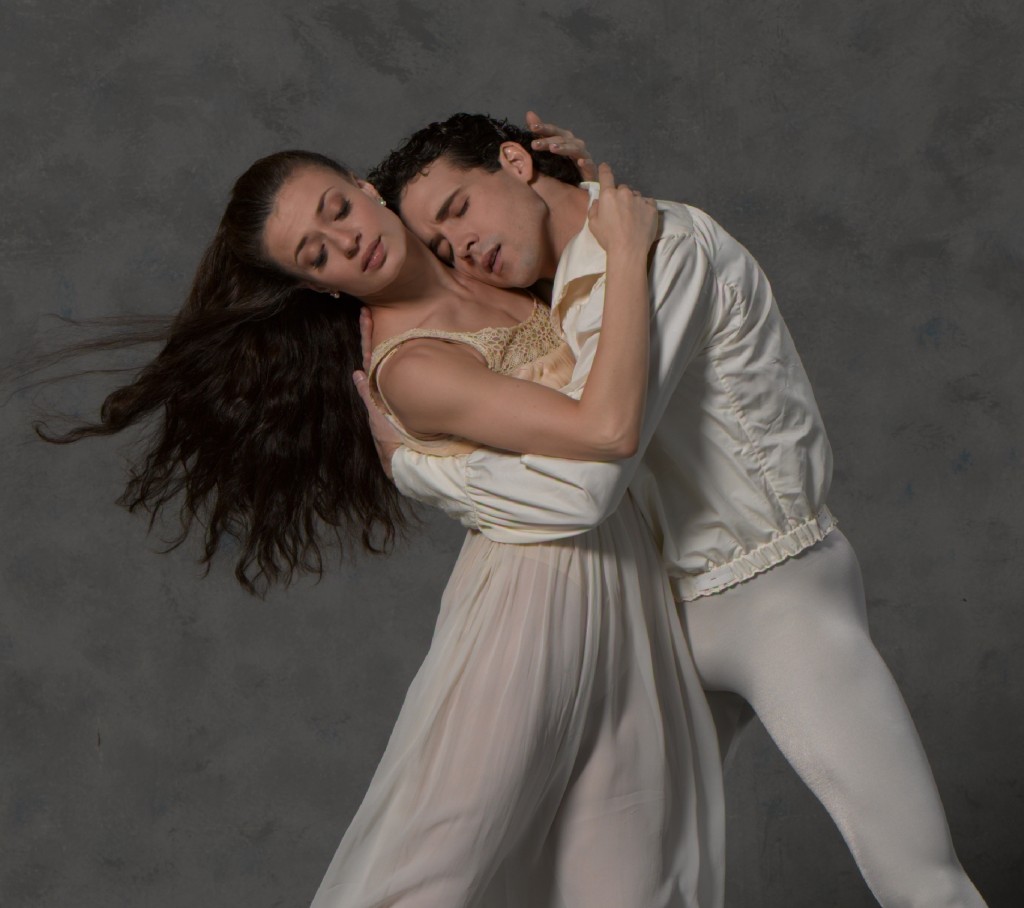Miami City Ballet closes 25th season with spectacular “Romeo and Juliet”

Jennifer Kronenberg and Carlos Guerra star in Miami City Ballet's "Romeo and Juliet," which opened Friday night at the Arsht Center in Miami. Photo: Lois Greenfield.
A tuxedoed and bejeweled audience turned out for the opening performance of Romeo and Juliet Friday night at the Arsht Center, the grand finale to the twenty-fifth anniversary season of Miami City Ballet. And John Cranko’s three-act extravaganza proved spectacular indeed.
There have been numerous choreographic treatments of Prokofiev’s iconic score. Originally conceived in 1962 for the Stuttgart Ballet, Cranko’s panoramic, larger-than-life approach was riveting . The late South African choreographer vividly brought to life the interrelated stories of Shakespeare’s star crossed lovers and the world of Verona, where joyous gatherings and carnivals could turn in an instant to violence. Cranko’s level of invention is consistently high, whether in the soaring pas de deux sequences for the protagonists or the many character dances and divertissements that fill the stage with action, color and drama. While the love scenes may lack the searing emotional power of Kenneth MacMillan’s famous realization and the death of Tybalt does not have the cataclysmic impact of Flemming Flindt’s production for the Royal Danish Ballet, Cranko’s wide-screen conception is terrific entertainment.
Cranko’s distinctive style takes flight in the lovers’ scenes with choreography that combines cinematic romantic imagery with sheer speed. Some of the most surprising moments are quiet and unexpected. The elegant bridesmaids’ dance and the carnival clowns’ quartet are memorable vignettes, totally original. Crowd scenes teem with brilliant peasant dances and exciting clashes of swordplay. The initial trio for Romeo, Mercutio and Benvolio is an athletic tour de force.
While Cranko created this romantic spectacle for the distinctive strengths of the dancers in his Stuttgart company, Miami City Ballet fielded a cast that met the choreographer’s formidable challenges on his own level. Staged by Stuttgart’s Jane Bourne, this production did not have a single weak link.
Juliet is the fulcrum around which Cranko wove his vision. Conceived for legendary Brazilian ballerina Marcia Haydee, the role requires reserves of stamina and the ability to reflect youth and tragic grandeur while executing a seemingly endless sequence of intricate movements. Jennifer Carlynn Kronenberg was simply terrific, meeting the role’s demands triumphantly. Light, fleet and impetuous, Kronenberg sailed through the lengthy role. In a stunning demonstration of technique and dance drama, she gave one of her finest performances.
Carlos Miguel Guerra was the athletic, noble Romeo. In his scenes with Kronenberg, the duo’s soaring lyrical line matched the music’s sensuous beauty. The angst-ridden romantic hero, Guerra exuded both bravado and emotional passion, dancing at fever pitch. Like Rudolf Nureyev, he not only danced but embodied Romeo. Kleber Rebello was the agile Mercutio, comedic and entertaining but poignant in a slow motion dance of death.
Among the large supporting cast, count Yann Trividic’s Paris a standout. His dance with Juliet in the ballroom scene exuded sexual tension. Callie Manning was an elegant Lady Capulet, dominating her scenes. Former MCB dancer Arnold Quintane returned for cameo duty in the mime roles of the Duke of Verona (pictured by Cranko as old and doddering) and Friar Lawrence. The ensemble scenes dazzled, the corps in top form.
After the poor orchestral performance of the Scotch Symphony at the ballet’s previous program, Prokofiev’s score was rendered capably opening night. Repeat performances should bring greater flexibility to the playing which seemed a too reticent at times and there were repeated horn burbles, marring the generally good ensemble effort. Gary Sheldon conducted a sensibly paced performance, capturing the sensuality of the love music and the quirky grace of the Gavotte (a retread from Prokofiev’s Classical Symphony) particularly effectively. The climactic scenes wanted greater weight and gravity.
MCB imported the National Ballet of Canada’s grandiose production. Susan Benson’s set and costume designs were eye-filling, the opening scene a replica of the ancient quarter of Verona. The show moved with the speed and ease of the best Broadway megamusical from one colorful setting to another. Lit in rich hues by Robert Thompson, this production was a feast for the senses. Romeo and Juliet marks the final flowering of romantic ballet and this spectacle was an important landmark for the constantly astounding Miami company.
The MCB 2011-2012 season brings two nineteenth-century, evening length French classics – Giselle and Coppelia. A new ballet, to a yet to be announced score, by British choreographer Liam Scarlett will be the season’s only premiere. Two pieces each by Balanchine (Square Dance and Ballet Imperial) and Jerome Robbins (Afternoon of a Faun and In the Night) and the controversial 1983 Twyla Tharp- Philip Glass collaboration In the Upper Room complete the lineup.
Miami City Ballet repeats Romeo and Juliet 2 p.m. Sunday at the Arsht Center in Miami, April 1-3 at the Kravis Center in West Palm Beach and April 29-May 1 at the Broward Center in Ft. Lauderdale. 305-929-7010 www.miamicityballet.org.
Posted in Performances
Leave a Comment
Sun Mar 27, 2011
at 11:54 am
No Comments






